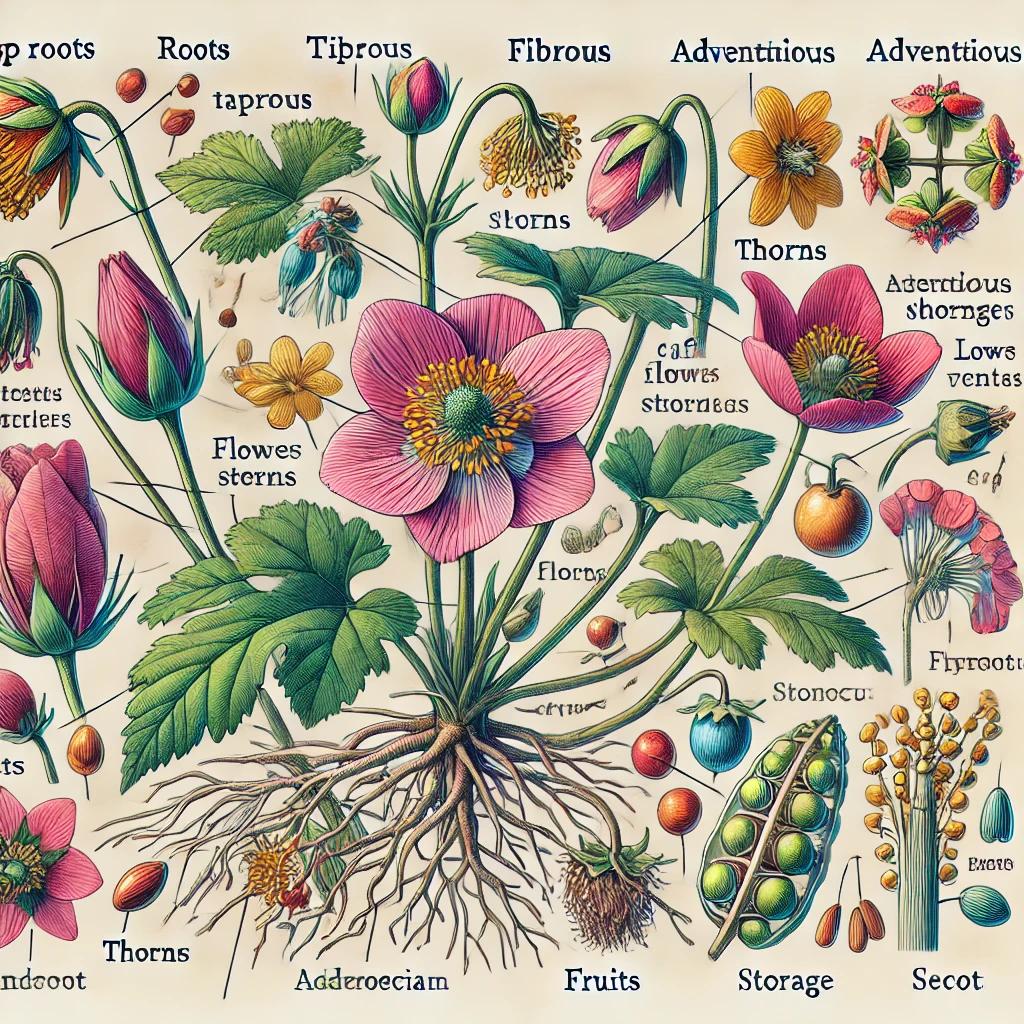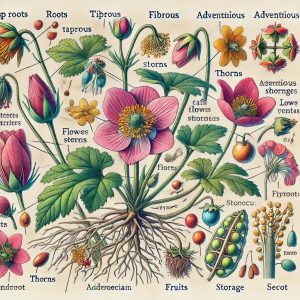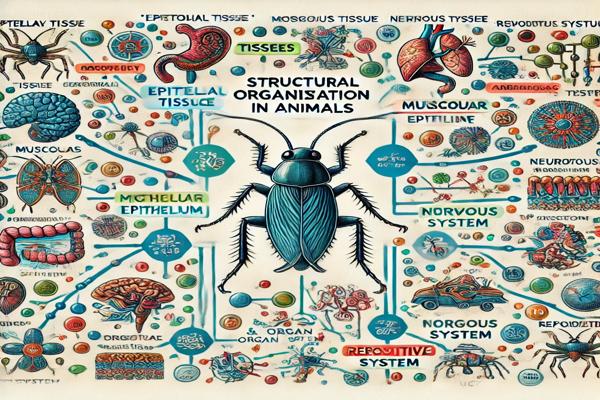Morphology of Flowering Plants

The study of the form and structure of flowering plants, or angiosperms, is termed morphology of flowering plants. This field encompasses the external features and modifications of roots, stems, leaves, flowers, fruits, and seeds, aiding in plant identification, taxonomy, and understanding adaptations for survival.
The Seed
A seed is the fertilized ovule containing an embryo. It marks the beginning of a plant’s life cycle and plays a crucial role in the reproductive process of flowering plants.
Structure of a Seed
- Plumule: The part of the embryo that develops into the shoot system, including the stem and leaves.
- Radicle: The embryonic root that grows downward to form the primary root system.
- Cotyledons: Seed leaves that store food to nourish the developing embryo.
- Seed Coat: The protective outer covering of the seed, consisting of two layers:
- Testa: The outermost, hard, and thick layer.
- Tegmen: The inner, thin, membranous layer.
- Hilum: A scar on the seed where it was attached to the fruit.
- Micropyle: A tiny pore near the hilum through which water enters the seed during germination.
Types of Seeds
- Dicotyledonous Seeds:
- Consist of two cotyledons that store food.
- Examples: Pea, gram, bean.
- Monocotyledonous Seeds:
- Have a single cotyledon called the scutellum.
- The embryo is protected by specialized coverings:
- Coleoptile: Covers the plumule.
- Coleorhiza: Covers the radicle.
- Examples: Maize, wheat, rice.
The Root
Roots are vital structures that anchor the plant in the soil and absorb water and nutrients. They can also store food and perform specialized functions.
Types of Roots
- Taproot System:
- The primary root grows directly downward and gives rise to lateral roots.
- Found in dicots.
- Examples: Carrot, mustard.
- Fibrous Root System:
- The primary root is short-lived, and many thin, thread-like roots arise from the base of the stem.
- Found in monocots.
- Examples: Wheat, rice.
- Adventitious Roots:
- Roots develop from parts of the plant other than the radicle, such as stems or leaves.
- Examples: Banyan tree (prop roots), grass (fibrous roots).
Regions of the Root
- Root Cap: Protects the growing tip of the root.
- Region of Meristematic Activity: Actively dividing cells near the root tip.
- Region of Elongation: Cells enlarge and elongate, contributing to root growth.
- Region of Maturation: Cells differentiate into specific tissues such as epidermis, cortex, and vascular tissue.
Root Modifications
- Storage Roots:
- Store food in the form of starch or other carbohydrates.
- Examples: Carrot, radish, turnip.
- Support Roots:
- Provide additional support to the plant.
- Examples:
- Prop roots: Banyan tree.
- Stilt roots: Maize, sugarcane.
- Respiratory Roots:
- Help in gaseous exchange in swampy or waterlogged conditions.
- Examples: Pneumatophores in mangroves like Rhizophora.
The Stem
The stem is the ascending part of the plant axis that develops from the plumule. It supports leaves, flowers, and fruits and conducts water, nutrients, and food.
Characteristics of the Stem
- Nodes and Internodes:
- Nodes: Points on the stem where leaves are attached.
- Internodes: Regions between two nodes.
- Axillary and Terminal Buds:
- Axillary buds are present in the axils of leaves and can grow into branches or flowers.
- The terminal bud helps in the elongation of the main stem.
Stem Modifications
- Storage Stems:
- Store food and help in perennation.
- Examples: Potato (tuber), ginger (rhizome), turmeric (rhizome).
- Climbing Stems:
- Modified into tendrils for support.
- Examples: Watermelon, cucumber.
- Protective Stems:
- Modified into thorns to protect against herbivores.
- Examples: Citrus, bougainvillea.
- Photosynthetic Stems:
- Flattened stems (phylloclades) perform photosynthesis.
- Example: Opuntia.
- Propagation Stems:
- Help in vegetative reproduction.
- Examples: Grass (runners), jasmine (suckers).
The Leaf
Leaves are lateral, flattened structures that arise from nodes and are specialized for photosynthesis. They also play a role in transpiration and gaseous exchange.
Structure of a Leaf
- Leaf Base: Attaches the leaf to the stem; may bear stipules (small leaf-like structures).
- Petiole: Stalk that connects the leaf blade to the base, providing flexibility and exposure to sunlight.
- Lamina (Leaf Blade): The green, flattened portion with veins and veinlets.
- Veins: Provide structural support and transport of water and nutrients.

Types of Venation
- Parallel Venation:
- Veins run parallel to each other.
- Found in monocots.
- Example: Grass, banana.
- Reticulate Venation:
- Veins form a network.
- Found in dicots.
- Example: Mango, peepal.
Types of Leaves
- Simple Leaves:
- Single lamina.
- Example: Mango, guava.
- Compound Leaves:
- Lamina is divided into leaflets.
- Pinnately compound: Leaflets arranged along a rachis (e.g., neem).
- Palmately compound: Leaflets radiate from a common point (e.g., silk cotton).
Phyllotaxy (Leaf Arrangement)
- Alternate: A single leaf grows at each node (e.g., mustard).
- Opposite: Two leaves grow opposite each other at a node (e.g., guava).
- Whorled: More than two leaves grow in a whorl at a node (e.g., Alstonia).
Leaf Modifications
- Tendrils:
- Provide support for climbing plants.
- Example: Pea.
- Spines:
- Reduce water loss and provide protection.
- Example: Cactus.
- Storage Leaves:
- Store water or food.
- Example: Onion, garlic.
- Insectivorous Leaves:
- Trap insects to obtain nutrients.
- Example: Pitcher plant, Venus flytrap.
The Inflorescence
Inflorescence refers to the arrangement of flowers on the floral axis.
Types of Inflorescence
- Racemose:
- The main axis continues to grow indefinitely, and flowers are borne laterally in an acropetal order.
- Examples: Mustard, radish.
- Cymose:
- The main axis terminates in a flower, and flowers are borne in a basipetal order.
- Examples: Jasmine, bougainvillea.
The Flower
The flower is the reproductive structure of angiosperms and consists of four main whorls.
Parts of a Flower
- Calyx:
- The outermost whorl made of sepals.
- Can be green (photosynthetic) or colored.
- Corolla:
- The whorl of petals, often brightly colored to attract pollinators.
- Androecium:
- The male reproductive whorl consisting of stamens.
- Each stamen has a filament and an anther.
- Gynoecium:
- The female reproductive whorl consisting of carpels.
- Each carpel has an ovary, style, and stigma.
Placentation
Arrangement of ovules in the ovary:
- Marginal: Pea.
- Axile: Lemon, tomato.
- Parietal: Mustard.
- Free central: Primrose.
- Basal: Sunflower.
The Fruit
Fruits develop from the ovary after fertilization. They protect the seeds and aid in their dispersal.
Parts of a Fruit
- Pericarp:
- Differentiated into epicarp (outer), mesocarp (middle), and endocarp (inner).
- Seeds:
- Develop from ovules and contain the embryo.
Types of Fruits
- Simple Fruits:
- Develop from a single ovary.
- Examples: Mango, tomato.
- Aggregate Fruits:
- Develop from multiple ovaries of a single flower.
- Examples: Strawberry, custard apple.
- Multiple Fruits:
- Develop from ovaries of multiple flowers in an inflorescence.
- Examples: Pineapple, jackfruit.
Conclusion
The morphology of flowering plants highlights their structural diversity and adaptations for survival, reproduction, and dispersal. This knowledge is essential for taxonomy, plant breeding, and understanding ecological interactions.
Read also
- Morphology in Botany – Britannica
- NCERT Textbook on Morphology of Flowering Plants
- Angiosperms Overview – Khan Academy
- Morphology of Flowering Plants Course – Coursera
Hi, I’m Hamid Ali, an MSc in Biotechnology and a passionate Lecturer of Biology with over 11 years of teaching experience. I have dedicated my career to making complex biological concepts accessible and engaging for students and readers alike.
Beyond the classroom, I’m an avid blogger, sharing insights, educational resources, and my love for science to inspire lifelong learning. When I’m not teaching or writing, I enjoy exploring new advancements in biotechnology and contributing to meaningful discussions in the scientific community.
Thank you for visiting my blog! Feel free to connect and explore more of my work.




